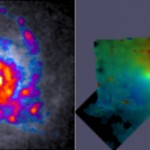W. M. Keck Observatory press release…
A team of Australian researchers used two Maunakea-based observatories – Gemini North and W. M. Keck Observatory – to discover why some galaxies are clumpy rather than spiral in shape and it appears that low spin is to blame. The finding challenges an earlier theory that high levels of gas cause clumpy galaxies, and sheds light on the conditions that brought about the birth of most of the stars in the Universe. The finding was published today in The Astrophysical Journal.

A combination of integral field spectroscopy data from Keck Observatory and Gemini Observatory was the key to obtaining measurements for a galaxy’s spin. Keck Observatory’s OSIRIS instrument collected data high spatial resolution in the galaxy centers, and the Gemini Multi-Object Spectrograph (GMOS) collected data for high surface brightness sensitivity out to large radii.
Lead author Dr. Danail Obreschkow, from The University of Western Australia (UWA) node of the International Centre for Radio Astronomy Research (ICRAR), said that ten billion years ago the Universe was full of clumpy galaxies, but these developed into more regular objects as they evolved; the majority of stars in the sky today, including our five billion-year-old Sun, were probably born inside these clumpy galaxies.
“The clumpy galaxies produce stars at phenomenal rates,” Dr. Obreschkow said. “A new star pops up about once a week, whereas spiral galaxies, like our Milky Way, only form about one new star a year.”
The research team – a collaboration between ICRAR and Swinburne University of Technology – focused on a few rare galaxies known as the DYNAMO galaxies, which still look clumpy even though they’re seen “only” 500 million years in the past. Obreschkow said looking at galaxies 500 million years ago was like looking at a passport photo taken a year ago.
“We see that galaxy the way it probably looks now… something could have happened to it, but it’s very unlikely,” Obreschkow said. “The galaxies that are 10 billion light years away are comparable to a picture from when you were three or four years old; that’s very different.”
The team combined high-resolution and large-radius spectroscopic maps taken from the Keck Observatory and Gemini Observatory in Hawai‘i to measure the spin of the galaxies and millimeter and radio telescopes to measure the amount of gas they contained. Obreschkow said the DYNAMO galaxies had a low spin, which was the dominant cause of their clumpiness, rather than their high gas content as previously thought.
“While the Milky Way appears to have a lot of spin, the galaxies we studied here have a low spin, about three times lower,” he said.
Glazebrook said the finding was exciting because the first observation that galaxies rotate was made exactly 100 years ago.
“Today we are still revealing the important role that the spin of the initial cloud of gas plays in galaxy formation,” Glazebrook said. “This novel result suggests that spin is fundamental to explaining why early galaxies are gas-rich and lumpy while modern galaxies display beautiful symmetric patterns.”

